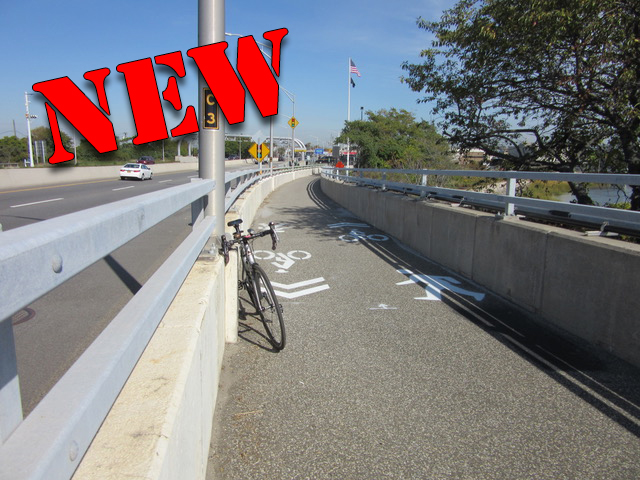Cyclists Will Finally Be Welcome on Cross Bay and Henry Hudson Bridges
12:10 PM EDT on October 26, 2022

The Cross Bay Bridge in Queens: Now with sharrows! Photo: Streetsblog tipster
Cyclists will finally be able to legally bike across the Cross Bay and Henry Hudson bridges, the MTA announced on Wednesday — the first big news since the agency was required by law last year to make a plan to expand cycling over its seven bridges in New York City.
Eagle-eyed riders have already noticed that sharrows painted on the Queens span, which connects Broad Channel and Rockaway, paint that legalized cycling on the formerly pedestrian-only, 10-foot-wide path that was frequently used by cyclists despite the ban.
Cyclists won't get to use the Henry Hudson Bridge, which connects northern Manhattan and the West Bronx, until the agency completes a major renovation of the lower level by 2025 that will include a lane wide enough for biking and walking (currently, the path only serves pedestrians). Next year, the MTA said it would award a contract for what is expected to be a two-year project that will finally save cyclists from the risk of a fine for using the existing pathway.
The announcement was wind in the wheels of Assembly Member Jessica Gonzalez-Rojas, who sponsored the 2021 bill that required the MTA to create the bike and pedestrian access plan
“I’m thrilled to hear this announcement today from the MTA," said the Queens lawmaker. "This is what we worked toward when along with advocates from Bike New York, Streets PAC, and more we introduced and passed the MTA Bike Access bill. Cycling has gone up since the beginning of the pandemic and it provides New Yorkers with a healthier and greener transit option. And bike access is also crucial for our deliveristas and people working to feed their families."

The bridge opening announcement comes two years after advocates and elected officials began ramping up the pressure on the MTA to let cyclists cross agency-owned bridges: the Henry Hudson, the Gil Hodges, the Cross Bay, the Robert F. Kennedy (formerly Triboro), the Whitestone, the Throgs Neck and the Verrazzano-Narrows.
"It's good, and it shows that the MTA is continuing to take the whole thing seriously," said Bike New York Director of Advocacy Jon Orcutt. "Two out of seven bridges is like pretty good progress for something that was nowhere two years ago."
There's one caveat to the opening of the Cross Bay Bridge: two-wheelers will have to walk their bikes at the treacherous southern end of the bridge, where the existing ramp is so steeply sloped that currently violates the Americans With Disabilities Act.
But Jessica Mathew, the MTA's senior adviser for special projects, said the ban is only temporary; the agency will award a contract by the end of 2022 to rebuild the Rockaway ramp to make the steep curve more gradual and, only then, usable by cyclists.
In addition to the bridge openings, the MTA also announced that it had worked with the city Department of Transportation to identify 37 subway stations that don't have bike racks within 100 feet so that the DOT can install bike parking at them, with the eventual goal of getting bike parking at every subway stop in the city. The bike parking will be traditional street racks, but Mathew noted that many people who commented on the MTA's initial outreach asked for secure bike parking near the subway. She also said that the city's recent RFEI for secure bike parking ideas could help meet that demand.
The partnership on bike parking could even signal a shift in how bike lane planning and outreach works in the city going forward, with Mathew saying that the MTA won't shy away from supporting bike network expansions near its stations.
"We defer to DOT subject matter experts on that stuff," she said, "but I think it's helpful for us to be part of the macro conversations on where our high-level priorities are and having a desire to have bike networks lead as close to a station entrance as possible.
"We are totally willing to participate in those community outreach discussions and things like that where there are areas that we think there's a huge benefit, like say because people are taking a very long ride to the nearest subway station. We've done the outreach with the bus lane projects, for example, and it's something that as part of this project, we'd want to make sort of a standard that we use going forward too," she added.
Wednesday's announcement focused on the lower-hanging fruit as the MTA prepares to release its larger Bike, Pedestrian, and Micromobility Strategic Action Plan at the end of 2022, a document that is expected to contain short-, medium- and long-term plans. It will also likely not include a bike path on the Verrazzano Bridge in any of those plans; not only has the MTA previously sandbagged the project, but Mathew said the Verrazzano is "probably the most challenging of all of our bridges to make fully accessible.
As such, it will have to be included in a future "20-year needs assessment" process. Plus, the cash-strapped agency will probably conclude that there's not enough bang in that bike path buck.
"You're well aware of where the MTA is, in terms of risks to both our operating and capital budgets," Mathew said. "We have to make tradeoffs, and thinking about demand and equity is front and center."
Mathew did say that a more near-term idea that's being looked at is expanding the number of buses with bike racks that use the Verrazzano, a practice currently limited to just the S53 and S93.
Another future plan that Mathew said cyclists could look forward to is the MTA finally taking seriously the idea of opening the Triboro (aka Robert F. Kennedy) Bridge to cyclists, which Orcutt noted is a heavily biked bridge despite the current bike ban.
"We're going to really be looking at the RFK bridge, and planning is underway for future projects there, because like the Henry Hudson, we think there's lots of latent demand for cycling given the proximity to Manhattan and travel patterns in the area," said Mathew.
The full list of subway stations slated for bike parking is:
- 176th Street (4)
- E 143rd St - St. Mary's Street (6)
- 96th Street (B/C)
- 71st Street (D)
- 79st Street (D)
- Bay 50th Street (D)
- Coney Island - Stillwell (D/F/N/Q)
- Canarsie - Rockaway Pkwy (L)
- E. 105th Street (L)
- Broadway Junction (A/C/J/Z/L)
- Atlantic Avenue (L)
- Shepherd Avenue (A/C)
- Cypress Hills (J)
- Alabama Avenue (J/Z)
- Classon Avenue (G)
- Brighton Avenue (Q)
- Beverley Road (Q)
- Bay Parkway (F)
- Jackson Heights - Roosevelt Avenue (7/E/F/M/R)
- Mets-Willets Point (7)
- Metropolitan Avenue (L)
- Myrtle-Wyckoff (L) (M)
- Fresh Pond Road (M)
- Halsey Street (L)
- Bushwick-Aberdeen (L)
- Eastchester-Dyre Avenue (5)
- Baychester Avenue (5)
- Morris Park (5)
- E. 180th Street (2,5)
- Bronx Park East (2,5)
- Beach 67tg Street (A)
- Howard Beach JFK Airport (A)
- Aqueduct (A)
- Far Rockaway Mott Avenue (A)
- Beach 25th Street (A)
- Beach 36th Street (A)
- Beach 60th Street (A)
Dave Colon is a reporter from Long Beach, a barrier island off of the coast of Long Island that you can bike to from the city. It’s a real nice ride. He’s previously been the editor of Brokelyn, a reporter at Gothamist, a freelance reporter and delivered freshly baked bread by bike. Dave is on Twitter as @davecolon. Email Dave Colon at dcolon@streetsblog.org
Stay in touch
Sign up for our free newsletter
More from Streetsblog New York City
Thursday’s Headlines: Speed-Limiting Tech Edition
State Sen. Andrew Gounardes continues his push to force reckless drivers to install speed limiters in their cars. Plus more news.
DOT Official: All Our Free Parking Justifies Keeping Curb Space for EVs
If only someone could do something about the parking!
New York City to Install 500 Secure Bike Parking Hubs In The Next Five Years: Sources
Your bike may finally get a roof over its head.
Adams Backs Lower Speed Limits, Calls Crashes ‘Accidents’
The mayor wants New York City drivers to "slow down," but it's not clear yet how many streets will get lower speed limits.
Wednesday’s Headlines: Trump Posts About Congestion Pricing Edition
Donald Trump comments on congestion pricing — no surprise, he's against it. Plus more news.




